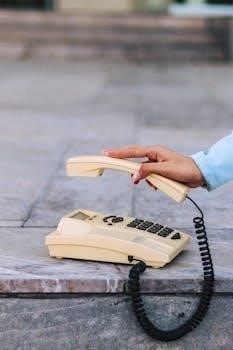Oster Microwave Oven User Manual⁚ A Comprehensive Guide
Welcome! This guide helps you safely operate your Oster microwave. Learn about precautions to avoid excessive microwave energy exposure. Keep your appliance in good condition following these instructions. We provide you with everything necessary to operate it correctly.
Understanding Microwave Safety Precautions
Microwave ovens offer a convenient way to heat food, but it’s crucial to prioritize safety. This section outlines essential precautions to prevent accidents and ensure safe operation of your Oster microwave. Start by never operating the microwave empty, as this can damage the magnetron tube, the heart of your microwave’s heating system.
Always use microwave-safe containers. Metal containers or dishes with metallic trim can cause arcing and sparks, potentially leading to fire or damage to the appliance. Ensure that any plastic containers are labeled as microwave-safe, and avoid using disposable plastic containers that may melt or warp under high heat.
Be cautious when heating liquids. They can become superheated, meaning they reach temperatures above boiling point without showing signs of boiling. This can result in sudden, explosive boiling when the container is moved or disturbed. To prevent this, place a microwave-safe stirrer in the liquid before heating, and heat in short intervals, stirring in between.
Regularly inspect the microwave for any signs of damage, such as a cracked door, damaged seals, or a malfunctioning latch. Do not operate the microwave if any damage is present. Contact a qualified technician for repairs. These safety measures are designed for your protection.

Identifying Your Oster Microwave Model
Locating the correct model number is crucial for accessing specific information about your Oster microwave, including compatible accessories, replacement parts, and detailed operating instructions. The model number is typically found on a label affixed to the back or side of the microwave oven. It might also be located inside the door frame.
Once you’ve found the label, look for a combination of letters and numbers, such as “OGYM1602” or “OTM1101GBS.” This alphanumeric code is your microwave’s unique identifier. Note it down carefully, as even a single incorrect digit can lead to inaccurate search results and mismatched information.
With the model number in hand, you can easily access the digital user manual on the Oster website. Enter the model number into the search bar to find the corresponding manual, which will provide detailed information about your specific microwave’s features, functions, and safety guidelines.
Having the correct model number also streamlines troubleshooting. If you encounter any issues with your microwave, knowing the model number will help you find relevant solutions and contact Oster customer support for assistance. This proactive approach can save you time and ensure you receive the appropriate support.
Initial Setup and Basic Operation
Before using your Oster microwave, ensure proper setup. Remove all packing materials from inside and outside the oven. Place it on a level surface, ensuring adequate ventilation around all sides. Avoid placing it near heat sources or in areas with high humidity.
Plug the microwave into a grounded electrical outlet. Ensure the voltage matches the specifications on the microwave’s label. Before first use, wipe the interior with a damp cloth to remove any manufacturing residue. Familiarize yourself with the control panel, identifying the buttons for power levels, cooking time, and function selection.
To begin basic operation, place food in a microwave-safe container. Open the microwave door and position the container in the center of the turntable. Close the door securely. Use the control panel to set the desired cooking time and power level. Press the “Start” button to initiate the cooking process.
During operation, monitor the food to prevent overcooking. You can pause the cooking cycle by pressing the “Stop” button or opening the door. Once the timer reaches zero, the microwave will automatically stop, and a signal will sound. Carefully remove the food, using oven mitts to protect against burns. Enjoy your meal!
Exploring Cooking Functions and Power Levels
Your Oster microwave offers various cooking functions and power levels to cater to different food types and cooking needs. Understanding these options allows you to achieve optimal results. The cooking functions may include microwave, grill, convection, and combinations of these.
The microwave function uses electromagnetic waves to heat food quickly. The grill function provides browning and crisping, similar to a conventional grill. The convection function circulates hot air for even cooking and baking. Combination functions utilize multiple heating methods for enhanced results.
Power levels control the intensity of the microwave energy. Higher power levels cook food faster, while lower levels are suitable for delicate items or reheating. Experiment with different power levels to find the ideal setting for each dish. Start with the recommended power level in your recipe and adjust as needed.
To select a cooking function, press the corresponding button on the control panel. Adjust the power level using the designated buttons. Set the cooking time according to your recipe or desired doneness. Always use microwave-safe cookware to ensure safe and efficient heating. Monitor the food during cooking and adjust settings as necessary to achieve perfect results.
Using Auto Cook Settings
Oster microwaves often feature auto cook settings, designed for convenience and ease of use. These pre-programmed settings automatically adjust the cooking time and power level for specific food items, taking the guesswork out of meal preparation. Common auto cook options include popcorn, potato, pizza, frozen vegetables, and beverages;
To utilize an auto cook setting, simply select the corresponding option on the control panel. You may need to enter the weight or quantity of the food item for accurate cooking. The microwave will then automatically determine the appropriate cooking time and power level. Monitor the food during cooking, especially for the first time, to ensure desired results.
Auto cook settings are a great starting point, but adjustments may be necessary based on your preferences and the specific characteristics of the food. Factors such as food density, starting temperature, and desired doneness can influence cooking time. If the food is not fully cooked, extend the cooking time in small increments.
Refer to your user manual for a complete list of available auto cook settings and specific instructions for each. Experiment with different settings to discover the best results for your favorite dishes. Auto cook settings can save you time and effort, making meal preparation more convenient than ever.
Cleaning and Maintenance Procedures
Regular cleaning and maintenance are crucial for keeping your Oster microwave in optimal condition and ensuring its longevity. Unplug the microwave before cleaning to prevent electrical shock. Wipe the interior and exterior surfaces with a damp cloth and mild detergent. Avoid using abrasive cleaners, scouring pads, or harsh chemicals, as these can damage the finish.
For stubborn stains or food splatters, heat a cup of water with a few tablespoons of lemon juice or vinegar in the microwave for several minutes. The steam will help loosen the debris, making it easier to wipe away. Clean the turntable and roller ring regularly with warm, soapy water. Ensure they are completely dry before reassembling.
Pay attention to the door seals and hinges, keeping them free from food particles and debris. Check the waveguide cover (the small rectangular area on the side or top of the microwave interior) and clean it gently if necessary. Never operate the microwave without the turntable and roller ring in place.
Periodically inspect the power cord for damage and replace it if needed. If you notice any unusual noises, sparks, or odors, discontinue use and contact a qualified technician for repair. Proper cleaning and maintenance will help your Oster microwave function efficiently and safely for years to come.
Troubleshooting Common Issues
Encountering issues with your Oster microwave can be frustrating, but many problems have simple solutions. If the microwave isn’t turning on, first ensure it’s properly plugged into a functioning outlet. Check the circuit breaker or fuse box to rule out a power outage. If the display is lit but the microwave isn’t heating, verify that the door is securely closed and latched.

Uneven cooking can often be attributed to improper food placement or using unsuitable cookware. Make sure food is evenly distributed on the turntable and that you’re using microwave-safe containers. If the turntable isn’t rotating, check if it’s properly seated on the roller ring and that there are no obstructions.
Sparks inside the microwave are usually caused by metal objects. Immediately stop the microwave and remove any metal utensils, foil, or dishes with metallic trim. If you notice unusual noises, such as loud humming or grinding, it could indicate a problem with the motor or other internal components. In such cases, it’s best to contact a qualified technician.
If you’re experiencing persistent issues that you can’t resolve, consult the digital user manual or contact Oster’s customer support for further assistance. Remember, attempting to repair the microwave yourself can be dangerous and may void your warranty.

Guide to Suitable Cooking Utensils
Selecting the right cooking utensils is crucial for safe and efficient microwave use. Metal cookware is strictly prohibited as it can cause sparks, fires, and damage to the microwave. Opt for microwave-safe materials such as glass, ceramic, and certain types of plastic. Look for the “microwave-safe” symbol on the bottom of the utensil to ensure its suitability.
Avoid using containers with metallic decorations or trim, as these can also cause arcing. Plastic containers should be heat-resistant and designed for microwave use to prevent melting or leaching of harmful chemicals into your food. Some plastics are not microwave-safe and can become brittle or release toxins when heated.
Paper plates and cups can be used for short heating times, but avoid prolonged cooking as they can become soggy or catch fire. Always ensure that paper products are not coated with wax or plastic. When using plastic wrap, leave a small vent to allow steam to escape and prevent pressure buildup.
For best results, use round or oval-shaped dishes as they promote even cooking. Avoid using square or rectangular containers with corners, as these can cause food to overcook in the corners and undercook in the center. Always follow the manufacturer’s recommendations for utensil compatibility to ensure safe and effective microwave cooking.
Deciphering Error Codes
Oster microwave ovens, like other electronic appliances, may display error codes to indicate specific issues. These codes are designed to help users troubleshoot problems and resolve them efficiently. Understanding these codes can save time and prevent unnecessary service calls. When an error code appears, immediately note it down as it provides valuable information about the malfunction.
Common error codes often relate to sensor malfunctions, door issues, or internal component failures. For instance, an error code indicating a door malfunction suggests that the door is not properly closed or the door switch is faulty. Sensor-related errors may point to problems with the temperature or humidity sensors, affecting the oven’s ability to cook food accurately.
If you encounter an error code, consult the user manual for a detailed explanation and recommended solutions. The manual typically lists common error codes and provides step-by-step instructions on how to address them. Simple solutions may include resetting the microwave, checking the power supply, or ensuring proper ventilation.
In some cases, resolving an error code may require professional assistance. If the troubleshooting steps in the manual do not resolve the issue, contact Oster customer support or a qualified appliance technician. Attempting to repair internal components without proper training can be dangerous and may void the warranty. Always prioritize safety and seek expert help when needed.
Accessing the Digital User Manual
In today’s digital age, accessing user manuals online is a convenient alternative to traditional paper copies. Oster provides digital user manuals for its microwave ovens, allowing users to easily find information and troubleshooting tips. These digital manuals are typically available on the Oster website in PDF format, which can be downloaded and viewed on computers, tablets, and smartphones.

To access the digital user manual for your specific Oster microwave model, visit the official Oster website and navigate to the “Support” or “Manuals” section. You can usually find the manual by entering the model number of your microwave in the search bar. The model number is typically located on a sticker on the back or inside the microwave oven.
Once you have located the digital user manual, you can download it to your device for offline access. The PDF format allows you to easily search for specific keywords or topics within the manual. This can be particularly helpful when troubleshooting issues or learning about advanced features.
In addition to the Oster website, some third-party websites and online databases also host user manuals for various appliances. However, it is always recommended to download the manual from the official Oster website to ensure that you have the most accurate and up-to-date information. Using the official source guarantees the safety and reliability of the document.

